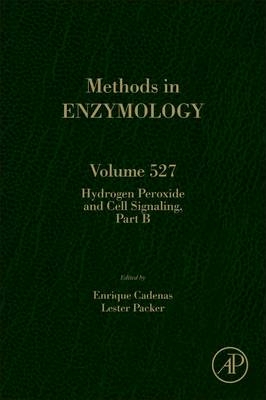
Hydrogen Peroxide and Cell Signaling, Part B
Academic Press Inc (Verlag)
978-0-12-405882-8 (ISBN)
This new volume of Methods in Enzymology continues the legacy of this premier serial with quality chapters authored by leaders in the field. This is the second of three volumes on hydrogen peroxide and cell signaling, and includes chapters on such topics as the cellular steady-state of H2O2, evaluating peroxiredoxin sensitivity towards inactivation by peroxide substrates, and peroxiredoxins as preferential targets in H2O2-induced signaling.
Lester Packer received a PhD in Microbiology and Biochemistry in 1956 from Yale University. In 1961, he joined the University of California at Berkeley serving as Professor of Cell and Molecular Biology until 2000, and then was appointed Adjunct Professor, Pharmacology and Pharmaceutical Sciences, School of Pharmacy at the University of Southern California. Dr Packer received numerous distinctions including three honorary doctoral degrees, several distinguished Professor appointments. He was awarded Chevalier de l’Ordre National du Merite (Knight of the French National Order of Merit) and later promoted to the rank of Officier. He served as President of the Society for Free Radical Research International (SFRRI), founder and Honorary President of the Oxygen Club of California. He has edited numerous books and published research; some of the most cited articles have become classics in the field of free radical biology: Dr Packer is a member of many professional societies and editorial boards. His research elucidated - the Antioxidant Network concept. Exogenous lipoic acid was discovered to be one of the most potent natural antioxidants and placed as the ultimate reductant or in the pecking order of the “Antioxidant Network regenerating vitamins C and E and stimulating glutathione synthesis, thereby improving the overall cellular antioxidant defense. The Antioxidant Network is a concept addressing the cell’s redox status. He established a world-wide network of research programs by supporting and co-organizing conferences on free radical research and redox biology in Asia, Europe, and America. ENRIQUE CADENAS, MD, PhD, received his PhD in biochemistry from the University of Buenos Aires, School of Medicine. He is professor of pharmacology and pharmaceutical sciences at the University of Southern California School of Pharmacy and of biochemistry and molecular biology at the University of Southern California Keck School of Medicine, and doctor honoris causa (medicine) at the University of Linköping, Sweden. Cadenas was president of the Society for Free Radical Research International (SFRRI) and is fellow of the Society for Free Radical Biology & Medicine. He served the scientific community by participating on NIH study sections (2002-2006; chair 2006-2008). His research interests include energy and redox metabolism in brain aging and the coordinated inflammatory-metabolic responses in brain and neurodegenerative diseases.
1. The Cellular Steady-State of H2O2: Latency Concepts and Gradients
2. Evaluating Peroxiredoxin Sensitivity Towards Inactivation by Peroxide Substrates
3. Peroxiredoxins as Preferential Targets in H2O2-Induced Signaling
4. Selenium in the Redox Regulation of the Nrf2 and the Wnt Pathway
5. Selenoprotein W as Biomarker for the Efficacy of Selenium Compounds to Act as Source for Selenoprotein Biosynthesis
6. Peroxiredoxins and Sulfiredoxin at the Crossroads of the No and H2o2 Signaling Pathways
7. Glutathione and g-glutamylcysteine in Hydrogen Peroxide Detoxification
8. Peroxiredoxin-6 and NADPH Oxidase Activity
9. Study of the Signaling Function of Sulfiredoxin and Peroxiredoxin III in Isolated Adrenal Gland: Unsuitability of Clonal and Primary Adrenocortical Cells
10. The Use of HyPer to Examine Spatial and Temporal Changes in H2O2- in High Light-Exposed Plants
11. Analysis of Environmental Stress in Plants with the Aid of Marker Genes for H2O2 Responses
12. The Role of Plant Bax Inhibitor-1 in Suppressing H2O2-Induced Cell Death
13. Comparative Analysis of Cyanobacterial and Plant Peroxiredoxins and their Electron Donors: Peroxidase Activity and Susceptibility to Overoxidation
14. Using Hyper as a Molecular Probe to Visualize Hydrogen Peroxide in Living Plant cells: A Method with Virtually Unlimited Potential in Plant Biology
| Reihe/Serie | Methods in Enzymology |
|---|---|
| Verlagsort | San Diego |
| Sprache | englisch |
| Maße | 152 x 229 mm |
| Gewicht | 720 g |
| Themenwelt | Medizin / Pharmazie ► Medizinische Fachgebiete |
| Studium ► 1. Studienabschnitt (Vorklinik) ► Physiologie | |
| Naturwissenschaften ► Biologie ► Biochemie | |
| Naturwissenschaften ► Biologie ► Zellbiologie | |
| ISBN-10 | 0-12-405882-5 / 0124058825 |
| ISBN-13 | 978-0-12-405882-8 / 9780124058828 |
| Zustand | Neuware |
| Haben Sie eine Frage zum Produkt? |
aus dem Bereich


